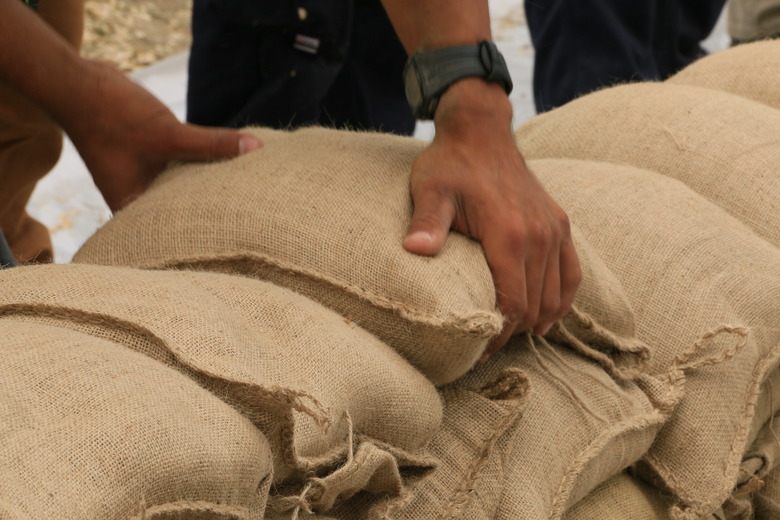How To Make And Use Sandbags To Contain Flooding
We may receive a commission on purchases made from links.
Although not a guarantee that your property will escape flooding altogether, sandbags really do slow floodwaters and help minimize property damage. They're more effective, however, when used correctly. There certainly isn't an exact sandbag science you need to study, but there is a right way and a wrong way to use sandbags for flood protection. The more you learn about using sandbags now, the better prepared you'll be when the water is rising.
Get Sandbags Now
Get Sandbags Now
Ever try to buy a snow shovel right before a blizzard? If so, you already know where this is going. Sand and sandbags tend to be in short supply after a storm system appears on the local weather radar, so stock up now. It takes about 600 sandbags to build a wall that is 1 foot high and 100 feet long. A standard sandbag, filled properly, will hold about 50 pounds of sand. This will give you some idea of what you need.
Store-bought sandbags are made of burlap or a substance known as polypropylene. Don't assume, however, that in a pinch any bag will do. Plastic bags slide off each other rather than stacking, and loosely woven bags won't hold the sand. The filler material can also prove problematic. Sand works best, and soil will do, but coarse dirt or gravel doesn't pack together tightly enough to stop water.
Sandbags may ultimately be fairly simple devices, but they are deceptively so. There are very specific traits that make sandbags ideal for stopping floodwater. It's far better to get the right tools for the job now when they're readily available than to scramble at the last minute.
Fill the Sandbags
Fill the Sandbags
Filling sandbags is easy but tiring work. It's a two-person operation, and both members of a sandbag-filing team need to take some precautions so they don't get hurt. The first is to wear sturdy work gloves to protect your hands.
The sandbag holder should sit on a stool or even an overturned bucket. This will get you closer to the ground and prevent a sore back and legs from constantly bending over. Place the bottom of the open bag between your feet, roll the neck of the bag down a bit, and then hold the neck of the bag open with your arms extended. The wider you can hold the bag open, the easier it will be to fill.
If you're filling the bag, work with your knees slightly bent and remember to lift each shovelful of sand with your knees rather than your back. Take the time to dip the shovel into the neck of the bag a bit before emptying it. The more sand that gets into the bag, the faster the job will go. Dumping the shovels too high above the bag only makes a mess and makes the whole process take longer. Fill each sandbag only a half to two-thirds of the way full.
When preparing sandbags during an emergency, there is no need to tie the bags shut at the top. You simply fold them over and keep on going as you build your wall. If you're preparing your bags in advance, however, it's a good idea to tie the bags shut. Always leave an air gap between the top of the sand and the tie. Without a gap, the sand won't be able to settle properly when you build your wall.
Place the Sandbags
Place the Sandbags
Sometimes, a few strategically placed sandbags are all you need. Before you begin building sandbag walls around your home, take a few bags and place them in your house. Lay sandbags over any floor drains in your basement, laundry room, or bathrooms to keep water and sewage from backing up into your home. Place a sandbag in front of any brickwork vents and lay a few across the bottom of exterior doors.
When stacking sandbags outside, never create a full circle around your home. Doing so can trap rain and floodwater in with you and can actually make your problems worse. Remember to build your wall parallel to the direction the floodwater will run. Place each sandbag adjacent to the one next to it and then tamp it firmly in place with your foot. As you build your wall higher, make sure you stagger the seams between sandbags so they aren't all at the same place and remember to tamp down each bag firmly.
If you need to go more than about 1 foot high, build your sandbag wall with a wide base like a pyramid. This will keep the wall sturdy and prevent floodwater from simply knocking it over. To divert as much water as possible away from your home, you can also secure a layer of plastic sheeting over your sandbag wall.
References
- LakeCounty TV: How To Properly Fill and Stack a Sandbag
- Sandbaggy.com: Sandbag Calculator (How Many Sandbags Needed)
- Queensland Government: Using Sandbags to Protect Your Home and Business
- Lowe's: How to Use Sand Bags to Prevent Flooding
- Lewis County, Washington: Sandbags – Frequently Asked Questions
